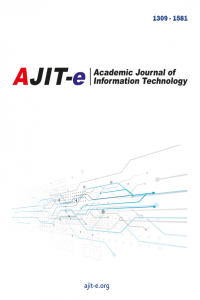Dijital ve Geleneksel Kitap Yayıncılığının Ülkelere Göre Değerlendirilmesi
Kitap yayıncılığının iş akışını ve teknolojisini etkileyen üç kırılma aşaması görülmektedir: 1. Kitapların elle yazılması ve çoğaltılması aşaması. 2. Matbaanın baskı teknolojisine dayalı kitlesel üretimi aşaması 3. Dijital teknolojiye (e-kitap) dayalı üretim ve dağıtım aşaması. Günümüz bilgi toplumunda uzun tarihsel süreç içerisinde elle yazılan ve çoğaltılan kitap üretimini yerinden eden matbaaya dayalı iş modeli, kitap endüstrisinin rekabet koşullarını belirleyen kitap üretim (kâğıt, baskı vb.) ve dağıtım giderlerini ortadan kaldıran dijital yayıncılık (e-yayıncılık) tarafından etkilenmektedir. Bu çalışmada kitap yayıncılığının mimarisini belirleyen üretim ve dağıtım teknolojisi tarihsel bağlamı üzerinden değerlendirilmiştir. Daha sonra özellikle Sanayi Devrimiyle ekonomik, teknik ve sosyal boyutuyla kitap yayıncılığını bir endüstriye dönüştüren bu taban üzerinden günümüze gelen kitap endüstrisinin ekonomik görünümü endüstrileşmiş ülkeler örneği bağlamında incelenmiştir. Kitap endüstrisinin tarihsel ve yapısal değişkenlerinin ekonomik ve teknolojik görünümünü ortaya koymayı amaçlayan bu çalışma, “literatür taramasına” ve “betimleme çalışmasına” dayanmaktadır. Kuzey Amerika ve Avrupa Birliği ülkeleri (Almanya, Fransa, İngiltere, İtalya, İspanya) ile Japonya ve Türkiye çalışmanın örneklemi olarak seçilmiştir. Japonya büyük bir ekonomik güç olması dolayısıyla örnekleme dahil edilmiş, Türkiye ise kitap yayıncılığının adı geçen ülkelerin genel görünümü içindeki yerinin görülmesi amacıyla çalışmaya dahil edilmiştir. Matbaa teknolojisini geç benimseyen Osmanlı mirası üzerinde olan, Avrupa ve Amerika’nın yaşadığı Sanayi Devrimi tecrübesi dışında kalan Türkiye’de, bu durum kitap yayıncılığının istenilen düzeyde gelişmesine engel olmuştur.
Anahtar Kelimeler:
Kitap Yayıncılığı, Geleneksel Kitap Yayıncılığı, E-Kitap, Kitap Endüstrisi
Evaluation of Digital and Traditional Book Publishing According to Countries
There are three breaking stages that affect the workflow and technology of book publishing: 1. The stage of writing and duplicating books by hand. 2. Stage of mass production of printing technology 3. Stage of production and distribution based on digital technology (e-book). In today's information society, the business model based on printing, which has displaced the production of books written and reproduced by hand in a long historical process, is changed by digital publishing (e-publishing), which decreased the costs of book production (paper, printing, etc.) and distribution, which determines the competitive conditions of the book industry. In this study, the production and distribution technology which determines the workflow of the book publishing is evaluated in its historical context. Later, the economic outlook of the book industry which has transformed book publishing into an industry with its economic, technical and social dimensions has been examined in the context of industrialized countries. This paper which aims to reveal the economic and technological view of the historical and structural variables of the book industry, is based on "literature review" and "descriptive study". North America and European Union countries (Germany, France, England, Italy, Spain), Japan and Turkey were chosen as the sample of the study. Japan was included in the sample because it is a great economic power, and Turkey was included in the study in order to see the place of book publishing in the general view of the mentioned countries.
___
- Anand, M. R. (1980). “Authors, Publishers and Booksellers.”, In D. N. Malhotra & N. Kumar (Eds.), Indian Publishing since Independence: A Festschrift Volüme, link:http://14.139.13.47:8080/jspui/bitstream/10603/218488/11/10%20chapter%203.pdf, (erişim tarihi 07.10.2020)
- Banham, R. (2007). “The Industrialization of the Book 1800–1970”, A Companion to the History of the Book, Edit. Simon Eliot and Jonathan Rose, Oxford, Blackwell Publishing.
- Bergström A., Höglund L. and DC (2017). “Books On Screens: Players In The Swedish E-Book Market”, Nordicom University of Gothenburg, Sweden, 2017.
- Deliorman, A. (1987). 1. Kitap Sempozyumu (15-17 Haziran 1981), Ankara; Kültür ve Turizm Bakanlığı, Kütüphaneler ve Yayımlar Genel Müdürlüğü, 1987.
- Erdoğanaras, F. (2004). "Basım ve Yayın Sektöründe Yeni Teknolojilere Dayalı Yeniden Yapılanma Süreci: İstanbul Örneği", Gazi Üniversitesi Mühendislik Mimarlık Fakültesi Dergisi, Cilt 19, No 1, 2004.
- Erken M. (2016). Türkiye’de Yayıncılık Alanının Dönüşümü (1980-2015), İstanbul Üniversitesi Sosyal Bilimler Enstitüsü, Yüksek Lisans Tezi, 2016.
- Hemmungs W. E. (2007). “The Global Market 1970–2000: Producers,” A Companion to the History of the Book, Ed. Simon Eliot, Jonathan Rose, Oxford, Blackwell Publishing, 2007.
- Japan Book Publishers Association (2017). An Introduction to Publishing in Japan 2017–2018”, https://authorzilla.com/ZzJra/an-introduction-to-publishing-in-japan.html (erişim tarihi, 11.12. 2021)
- Simon J. P., de Prat G. (2012). “Statistical, Ecosystems and Competitiveness Analysis of the Media and Content Industries: The Book Publishing Industry”, European Commission Joint Research Centre Institute for Prospective Technological Studies, 2012.
- Throsby D., Zwar J. & Morgan C. (2018). “Australian Book Publishers in the Global Industry: Survey Method and Results”, Macquarie University, Australia, 2018.
- Titiloye Oyeyink O., Aganbi V.E. & DC (2016). “Problems Of Book Publishing Industry In Nıgeria”, Journal of Research and Development (JRnD) Vol. 2, No. 10, 2016.
- Türkiye Yayıncılar Birliği (2019). “Türkiye Kitap Pazarı”, http://turkyaybir.org.tr/2019-turkiye-kitap-pazari-raporu/#.X1jho1UzbIV (erişim tarihi 9.9.2020)
- Zubac A., Tominac A. (2014) “A Research Of E-Book Market Trends: North Amerıca And The European Communıty”, Knjižnica, 58, 2014.
- Yayın Aralığı: Yılda 4 Sayı
- Başlangıç: 2010
- Yayıncı: Akademik Bilişim Araştırmaları Derneği
